Attached files
| file | filename |
|---|---|
| 8-K - 8-K - L3HARRIS TECHNOLOGIES, INC. /DE/ | a8-kfinancialresultstransc.htm |
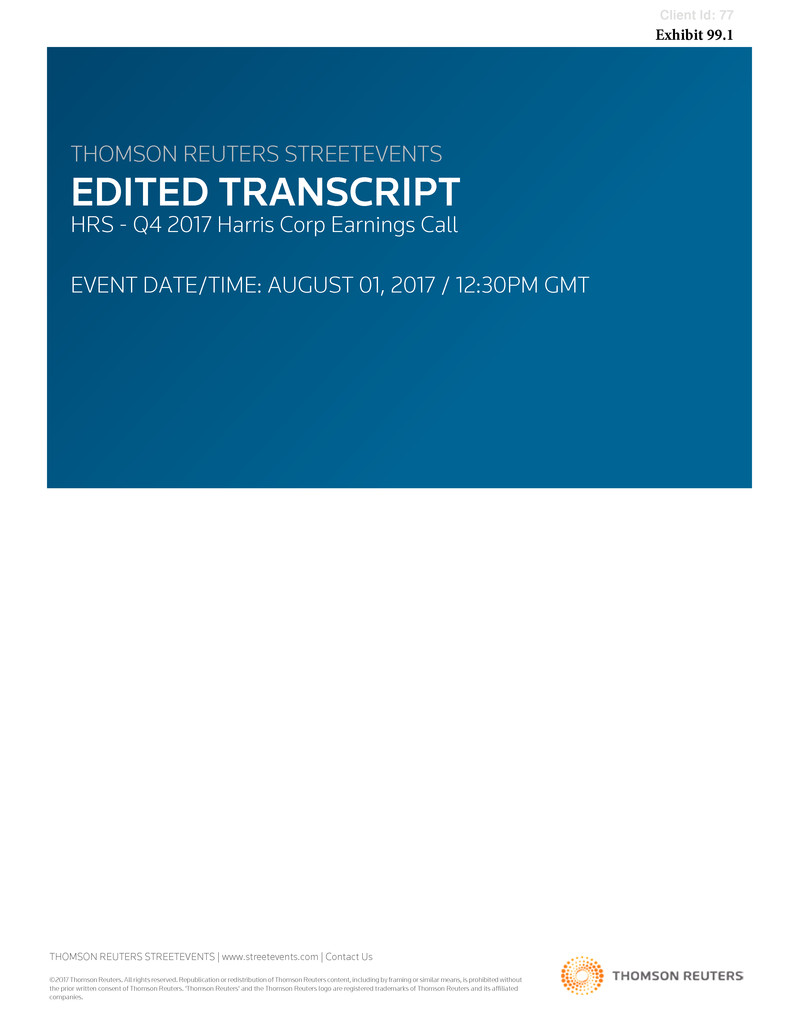
Client Id: 77
THOMSON REUTERS STREETEVENTS
EDITED TRANSCRIPT
HRS - Q4 2017 Harris Corp Earnings Call
EVENT DATE/TIME: AUGUST 01, 2017 / 12:30PM GMT
THOMSON REUTERS STREETEVENTS | www.streetevents.com | Contact Us
©2017 Thomson Reuters. All rights reserved. Republication or redistribution of Thomson Reuters content, including by framing or similar means, is prohibited without
the prior written consent of Thomson Reuters. 'Thomson Reuters' and the Thomson Reuters logo are registered trademarks of Thomson Reuters and its affiliated
companies.
Exhibit 99.1

Client Id: 77
C O R P O R A T E P A R T I C I P A N T S
Anurag Maheshwari
Rahul Ghai Harris Corporation - CFO and SVP
William M. Brown Harris Corporation - Chairman, CEO and President
C O N F E R E N C E C A L L P A R T I C I P A N T S
Gautam J. Khanna Cowen and Company, LLC, Research Division - MD and Senior Analyst
Howard Alan Rubel Jefferies LLC, Research Division - MD and Senior Equity Research Analyst of Aerospace and Defense Electronics
Jason Michael Gursky Citigroup Inc, Research Division - Director and Senior Analyst
Joshua Ward Sullivan Seaport Global Securities LLC, Research Division - Director & Senior Industrials Analyst
Noah Poponak Goldman Sachs Group Inc., Research Division - Equity Analyst
Peter John Skibitski Drexel Hamilton, LLC, Research Division - Senior Equity Research Analyst
Robert Alan Stallard Vertical Research Partners, LLC - Partner
Seth Michael Seifman JP Morgan Chase & Co, Research Division - Senior Equity Research Analyst
P R E S E N T A T I O N
Operator
Good day, ladies and gentlemen, and welcome to the Harris Corporation Fourth Quarter 2017 Earnings Conference Call. (Operator Instructions) As
a reminder, this conference call is being recorded. I would now like to turn the conference over to Anurag Maheshwari, Vice President of Investor
Relations.
Anurag Maheshwari
Thank you, LaToya. Good morning, everyone, and welcome to our fourth quarter fiscal 2017 earnings call. On the call with me today is Bill Brown,
Chairman and Chief Executive Officer; and Rahul Ghai, Senior Vice President and Chief Financial Officer.
First, a few words and forward-looking statements. Forward-looking statements made today involve assumptions, risks and uncertainties that
could cause actual results to differ materially from those statements. For more information and a related discussion, please see the press release,
the presentation and Harris' SEC filings.
In addition, discussions today will include non-GAAP financial measures, and a reconciliation of the non-GAAP measures discussed today to
comparable GAAP measures is included in the quarterly material on the Investor Relations section of our website, which is www.harris.com, where
a replay of this call also will be available.
With that, Bill, I will turn it over to you.
William M. Brown - Harris Corporation - Chairman, CEO and President
Okay. Well, thank you, Anurag, and good morning, everyone. We ended fiscal '17 on a high note, with fourth quarter earnings per share of 15%, a
top line growth of about 1%. For the year, earnings per share was up 8% to $5.53 on organic revenue down about 0.5%. Despite slower -- slightly
lower revenue, we expanded operating margins 50 basis points to 19.2% and generated record free cash flow of $850 million, 123% of income,
2
THOMSON REUTERS STREETEVENTS | www.streetevents.com | Contact Us
©2017 Thomson Reuters. All rights reserved. Republication or redistribution of Thomson Reuters content, including by framing or similar means, is prohibited without
the prior written consent of Thomson Reuters. 'Thomson Reuters' and the Thomson Reuters logo are registered trademarks of Thomson Reuters and its affiliated
companies.
AUGUST 01, 2017 / 12:30PM, HRS - Q4 2017 Harris Corp Earnings Call
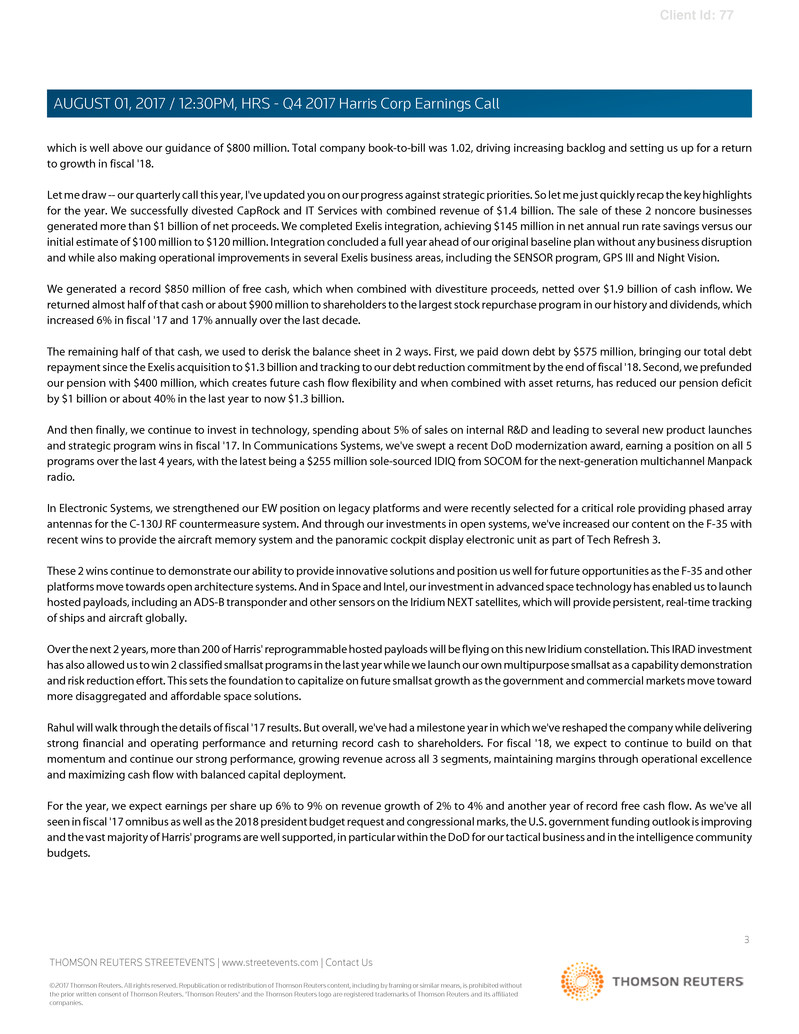
Client Id: 77
which is well above our guidance of $800 million. Total company book-to-bill was 1.02, driving increasing backlog and setting us up for a return
to growth in fiscal '18.
Let me draw -- our quarterly call this year, I've updated you on our progress against strategic priorities. So let me just quickly recap the key highlights
for the year. We successfully divested CapRock and IT Services with combined revenue of $1.4 billion. The sale of these 2 noncore businesses
generated more than $1 billion of net proceeds. We completed Exelis integration, achieving $145 million in net annual run rate savings versus our
initial estimate of $100 million to $120 million. Integration concluded a full year ahead of our original baseline plan without any business disruption
and while also making operational improvements in several Exelis business areas, including the SENSOR program, GPS III and Night Vision.
We generated a record $850 million of free cash, which when combined with divestiture proceeds, netted over $1.9 billion of cash inflow. We
returned almost half of that cash or about $900 million to shareholders to the largest stock repurchase program in our history and dividends, which
increased 6% in fiscal '17 and 17% annually over the last decade.
The remaining half of that cash, we used to derisk the balance sheet in 2 ways. First, we paid down debt by $575 million, bringing our total debt
repayment since the Exelis acquisition to $1.3 billion and tracking to our debt reduction commitment by the end of fiscal '18. Second, we prefunded
our pension with $400 million, which creates future cash flow flexibility and when combined with asset returns, has reduced our pension deficit
by $1 billion or about 40% in the last year to now $1.3 billion.
And then finally, we continue to invest in technology, spending about 5% of sales on internal R&D and leading to several new product launches
and strategic program wins in fiscal '17. In Communications Systems, we've swept a recent DoD modernization award, earning a position on all 5
programs over the last 4 years, with the latest being a $255 million sole-sourced IDIQ from SOCOM for the next-generation multichannel Manpack
radio.
In Electronic Systems, we strengthened our EW position on legacy platforms and were recently selected for a critical role providing phased array
antennas for the C-130J RF countermeasure system. And through our investments in open systems, we've increased our content on the F-35 with
recent wins to provide the aircraft memory system and the panoramic cockpit display electronic unit as part of Tech Refresh 3.
These 2 wins continue to demonstrate our ability to provide innovative solutions and position us well for future opportunities as the F-35 and other
platforms move towards open architecture systems. And in Space and Intel, our investment in advanced space technology has enabled us to launch
hosted payloads, including an ADS-B transponder and other sensors on the Iridium NEXT satellites, which will provide persistent, real-time tracking
of ships and aircraft globally.
Over the next 2 years, more than 200 of Harris' reprogrammable hosted payloads will be flying on this new Iridium constellation. This IRAD investment
has also allowed us to win 2 classified smallsat programs in the last year while we launch our own multipurpose smallsat as a capability demonstration
and risk reduction effort. This sets the foundation to capitalize on future smallsat growth as the government and commercial markets move toward
more disaggregated and affordable space solutions.
Rahul will walk through the details of fiscal '17 results. But overall, we've had a milestone year in which we've reshaped the company while delivering
strong financial and operating performance and returning record cash to shareholders. For fiscal '18, we expect to continue to build on that
momentum and continue our strong performance, growing revenue across all 3 segments, maintaining margins through operational excellence
and maximizing cash flow with balanced capital deployment.
For the year, we expect earnings per share up 6% to 9% on revenue growth of 2% to 4% and another year of record free cash flow. As we've all
seen in fiscal '17 omnibus as well as the 2018 president budget request and congressional marks, the U.S. government funding outlook is improving
and the vast majority of Harris' programs are well supported, in particular within the DoD for our tactical business and in the intelligence community
budgets.
3
THOMSON REUTERS STREETEVENTS | www.streetevents.com | Contact Us
©2017 Thomson Reuters. All rights reserved. Republication or redistribution of Thomson Reuters content, including by framing or similar means, is prohibited without
the prior written consent of Thomson Reuters. 'Thomson Reuters' and the Thomson Reuters logo are registered trademarks of Thomson Reuters and its affiliated
companies.
AUGUST 01, 2017 / 12:30PM, HRS - Q4 2017 Harris Corp Earnings Call

Client Id: 77
Internationally, we see similar trends towards modernization of capabilities and increased defense spending. These global trends, coupled with
our position on growing platforms and important missionary areas are translating into a very robust set of opportunities, spanning all segments,
resulting in an overall Harris pipeline that is up double digits over the past year to more than $30 billion.
A final comment before turning the call over to Rahul. I know there's been a lot of recent press coverage about the Army reevaluating a tactical
network architecture, a process that Harris is deeply involved in and supportive of. And we remain confident that the Army will move forward on
upgrading the lower tactical tier, including the Manpack and handheld programs.
There's a need to replace legacy SINCGARS radios with modern, multichannel radio that can simultaneously transmit voice and data, are
software-upgradable over time, meet new mandated NSA crypto standards and can interoperate with other U.S. and coalition forces. These are
undisputed requirements and our products are ready today.
The procurement process continues to advance, funding has increased in the '17 and '18 budgets. And just yesterday, we received the delivery
order for an additional 101 radios, which allow the Army to test it for threshold and operational requirements before moving to full rate production
in the first half of calendar '18.
So let me turn it over to Rahul to walk through the financial results and fiscal '18 guidance, and then I'll share some further thoughts about our
medium-term outlook. Rahul?
Rahul Ghai - Harris Corporation - CFO and SVP
Thank you, Bill, and good morning, everyone. As a reminder, discussions today are on a non-GAAP basis and exclude Exelis integration and other
costs. Turning now to segment details on Slide 6. Communication Systems revenue in the quarter was $449 million, up 3% versus prior year.
Operating income for the segment was up 22%, resulting in margin expansion of 500 basis points from higher tactical radio volume, integration
savings and the benefits of operational excellence initiatives.
Legacy tactical revenue grew 28% in the quarter and was about flat for the year versus previous guidance of down low single digits and down high
single digits at the beginning of the year. This strong performance in legacy tactical resulted in full year segment revenue down 6% versus our
previous guidance of down 7%.
Following the end of the CR, DoD tactical procurement picked up with the Air Force placing a $23 million order for radios for MRAP vehicles and
we ended with full year revenue growth of 3%, better than our previous expectation of flat revenues.
In international tactical, revenue was up 37% in the quarter over a relatively weak compare from last year. As expected, Eastern Europe continued
to be an area of strength, and we also saw positive signs in the Middle East with an order from Iraq and growth in the Asia Pacific region. Improving
conditions in international tactical market throughout the year resulted in full year revenue being down 1% versus our prior expectation of a
mid-single-digit decline and a midteens decline at the beginning of the year.
Regarding the Australian opportunity. In June, we've received a $19 million order to conduct risk reduction and planning activity for Australia's
Phase III modernization program. And in mid-July, the program was approved by Australia's DoD investment committee. Following that, issues to
Harris for an order of approximately $260 million for part of the Phase 3 modernization. This order is expected sometime later in the first quarter.
For full year fiscal 2017, segment revenue was $1.75 billion, with operating margin of 29.9%, up 80 basis points versus prior year. This margin
improvement was driven by synergies and the team's continued focus on cost and operational excellence. Book-to-bill for the segment was well
above 1 in the quarter with strong bookings in PSPC and legacy Exelis SINCGARS and greater than 1 for the year even with Australia moving better
to the right.
4
THOMSON REUTERS STREETEVENTS | www.streetevents.com | Contact Us
©2017 Thomson Reuters. All rights reserved. Republication or redistribution of Thomson Reuters content, including by framing or similar means, is prohibited without
the prior written consent of Thomson Reuters. 'Thomson Reuters' and the Thomson Reuters logo are registered trademarks of Thomson Reuters and its affiliated
companies.
AUGUST 01, 2017 / 12:30PM, HRS - Q4 2017 Harris Corp Earnings Call
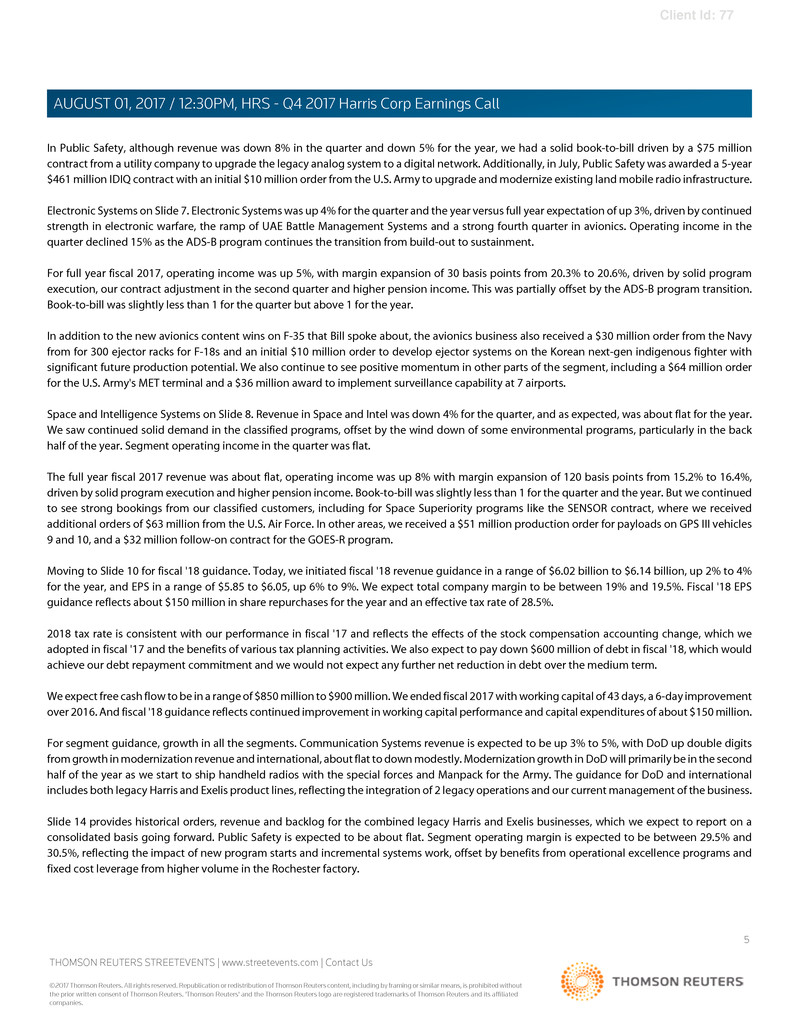
Client Id: 77
In Public Safety, although revenue was down 8% in the quarter and down 5% for the year, we had a solid book-to-bill driven by a $75 million
contract from a utility company to upgrade the legacy analog system to a digital network. Additionally, in July, Public Safety was awarded a 5-year
$461 million IDIQ contract with an initial $10 million order from the U.S. Army to upgrade and modernize existing land mobile radio infrastructure.
Electronic Systems on Slide 7. Electronic Systems was up 4% for the quarter and the year versus full year expectation of up 3%, driven by continued
strength in electronic warfare, the ramp of UAE Battle Management Systems and a strong fourth quarter in avionics. Operating income in the
quarter declined 15% as the ADS-B program continues the transition from build-out to sustainment.
For full year fiscal 2017, operating income was up 5%, with margin expansion of 30 basis points from 20.3% to 20.6%, driven by solid program
execution, our contract adjustment in the second quarter and higher pension income. This was partially offset by the ADS-B program transition.
Book-to-bill was slightly less than 1 for the quarter but above 1 for the year.
In addition to the new avionics content wins on F-35 that Bill spoke about, the avionics business also received a $30 million order from the Navy
from for 300 ejector racks for F-18s and an initial $10 million order to develop ejector systems on the Korean next-gen indigenous fighter with
significant future production potential. We also continue to see positive momentum in other parts of the segment, including a $64 million order
for the U.S. Army's MET terminal and a $36 million award to implement surveillance capability at 7 airports.
Space and Intelligence Systems on Slide 8. Revenue in Space and Intel was down 4% for the quarter, and as expected, was about flat for the year.
We saw continued solid demand in the classified programs, offset by the wind down of some environmental programs, particularly in the back
half of the year. Segment operating income in the quarter was flat.
The full year fiscal 2017 revenue was about flat, operating income was up 8% with margin expansion of 120 basis points from 15.2% to 16.4%,
driven by solid program execution and higher pension income. Book-to-bill was slightly less than 1 for the quarter and the year. But we continued
to see strong bookings from our classified customers, including for Space Superiority programs like the SENSOR contract, where we received
additional orders of $63 million from the U.S. Air Force. In other areas, we received a $51 million production order for payloads on GPS III vehicles
9 and 10, and a $32 million follow-on contract for the GOES-R program.
Moving to Slide 10 for fiscal '18 guidance. Today, we initiated fiscal '18 revenue guidance in a range of $6.02 billion to $6.14 billion, up 2% to 4%
for the year, and EPS in a range of $5.85 to $6.05, up 6% to 9%. We expect total company margin to be between 19% and 19.5%. Fiscal '18 EPS
guidance reflects about $150 million in share repurchases for the year and an effective tax rate of 28.5%.
2018 tax rate is consistent with our performance in fiscal '17 and reflects the effects of the stock compensation accounting change, which we
adopted in fiscal '17 and the benefits of various tax planning activities. We also expect to pay down $600 million of debt in fiscal '18, which would
achieve our debt repayment commitment and we would not expect any further net reduction in debt over the medium term.
We expect free cash flow to be in a range of $850 million to $900 million. We ended fiscal 2017 with working capital of 43 days, a 6-day improvement
over 2016. And fiscal '18 guidance reflects continued improvement in working capital performance and capital expenditures of about $150 million.
For segment guidance, growth in all the segments. Communication Systems revenue is expected to be up 3% to 5%, with DoD up double digits
from growth in modernization revenue and international, about flat to down modestly. Modernization growth in DoD will primarily be in the second
half of the year as we start to ship handheld radios with the special forces and Manpack for the Army. The guidance for DoD and international
includes both legacy Harris and Exelis product lines, reflecting the integration of 2 legacy operations and our current management of the business.
Slide 14 provides historical orders, revenue and backlog for the combined legacy Harris and Exelis businesses, which we expect to report on a
consolidated basis going forward. Public Safety is expected to be about flat. Segment operating margin is expected to be between 29.5% and
30.5%, reflecting the impact of new program starts and incremental systems work, offset by benefits from operational excellence programs and
fixed cost leverage from higher volume in the Rochester factory.
5
THOMSON REUTERS STREETEVENTS | www.streetevents.com | Contact Us
©2017 Thomson Reuters. All rights reserved. Republication or redistribution of Thomson Reuters content, including by framing or similar means, is prohibited without
the prior written consent of Thomson Reuters. 'Thomson Reuters' and the Thomson Reuters logo are registered trademarks of Thomson Reuters and its affiliated
companies.
AUGUST 01, 2017 / 12:30PM, HRS - Q4 2017 Harris Corp Earnings Call
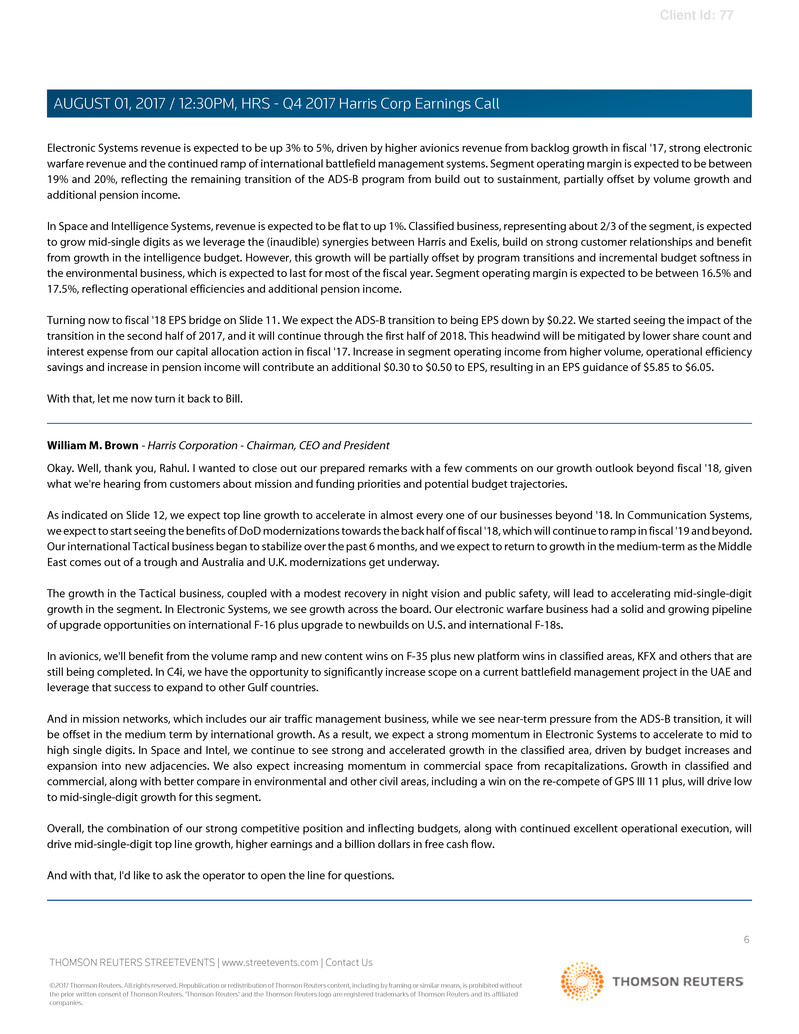
Client Id: 77
Electronic Systems revenue is expected to be up 3% to 5%, driven by higher avionics revenue from backlog growth in fiscal '17, strong electronic
warfare revenue and the continued ramp of international battlefield management systems. Segment operating margin is expected to be between
19% and 20%, reflecting the remaining transition of the ADS-B program from build out to sustainment, partially offset by volume growth and
additional pension income.
In Space and Intelligence Systems, revenue is expected to be flat to up 1%. Classified business, representing about 2/3 of the segment, is expected
to grow mid-single digits as we leverage the (inaudible) synergies between Harris and Exelis, build on strong customer relationships and benefit
from growth in the intelligence budget. However, this growth will be partially offset by program transitions and incremental budget softness in
the environmental business, which is expected to last for most of the fiscal year. Segment operating margin is expected to be between 16.5% and
17.5%, reflecting operational efficiencies and additional pension income.
Turning now to fiscal '18 EPS bridge on Slide 11. We expect the ADS-B transition to being EPS down by $0.22. We started seeing the impact of the
transition in the second half of 2017, and it will continue through the first half of 2018. This headwind will be mitigated by lower share count and
interest expense from our capital allocation action in fiscal '17. Increase in segment operating income from higher volume, operational efficiency
savings and increase in pension income will contribute an additional $0.30 to $0.50 to EPS, resulting in an EPS guidance of $5.85 to $6.05.
With that, let me now turn it back to Bill.
William M. Brown - Harris Corporation - Chairman, CEO and President
Okay. Well, thank you, Rahul. I wanted to close out our prepared remarks with a few comments on our growth outlook beyond fiscal '18, given
what we're hearing from customers about mission and funding priorities and potential budget trajectories.
As indicated on Slide 12, we expect top line growth to accelerate in almost every one of our businesses beyond '18. In Communication Systems,
we expect to start seeing the benefits of DoD modernizations towards the back half of fiscal '18, which will continue to ramp in fiscal '19 and beyond.
Our international Tactical business began to stabilize over the past 6 months, and we expect to return to growth in the medium-term as the Middle
East comes out of a trough and Australia and U.K. modernizations get underway.
The growth in the Tactical business, coupled with a modest recovery in night vision and public safety, will lead to accelerating mid-single-digit
growth in the segment. In Electronic Systems, we see growth across the board. Our electronic warfare business had a solid and growing pipeline
of upgrade opportunities on international F-16 plus upgrade to newbuilds on U.S. and international F-18s.
In avionics, we'll benefit from the volume ramp and new content wins on F-35 plus new platform wins in classified areas, KFX and others that are
still being completed. In C4i, we have the opportunity to significantly increase scope on a current battlefield management project in the UAE and
leverage that success to expand to other Gulf countries.
And in mission networks, which includes our air traffic management business, while we see near-term pressure from the ADS-B transition, it will
be offset in the medium term by international growth. As a result, we expect a strong momentum in Electronic Systems to accelerate to mid to
high single digits. In Space and Intel, we continue to see strong and accelerated growth in the classified area, driven by budget increases and
expansion into new adjacencies. We also expect increasing momentum in commercial space from recapitalizations. Growth in classified and
commercial, along with better compare in environmental and other civil areas, including a win on the re-compete of GPS III 11 plus, will drive low
to mid-single-digit growth for this segment.
Overall, the combination of our strong competitive position and inflecting budgets, along with continued excellent operational execution, will
drive mid-single-digit top line growth, higher earnings and a billion dollars in free cash flow.
And with that, I'd like to ask the operator to open the line for questions.
6
THOMSON REUTERS STREETEVENTS | www.streetevents.com | Contact Us
©2017 Thomson Reuters. All rights reserved. Republication or redistribution of Thomson Reuters content, including by framing or similar means, is prohibited without
the prior written consent of Thomson Reuters. 'Thomson Reuters' and the Thomson Reuters logo are registered trademarks of Thomson Reuters and its affiliated
companies.
AUGUST 01, 2017 / 12:30PM, HRS - Q4 2017 Harris Corp Earnings Call
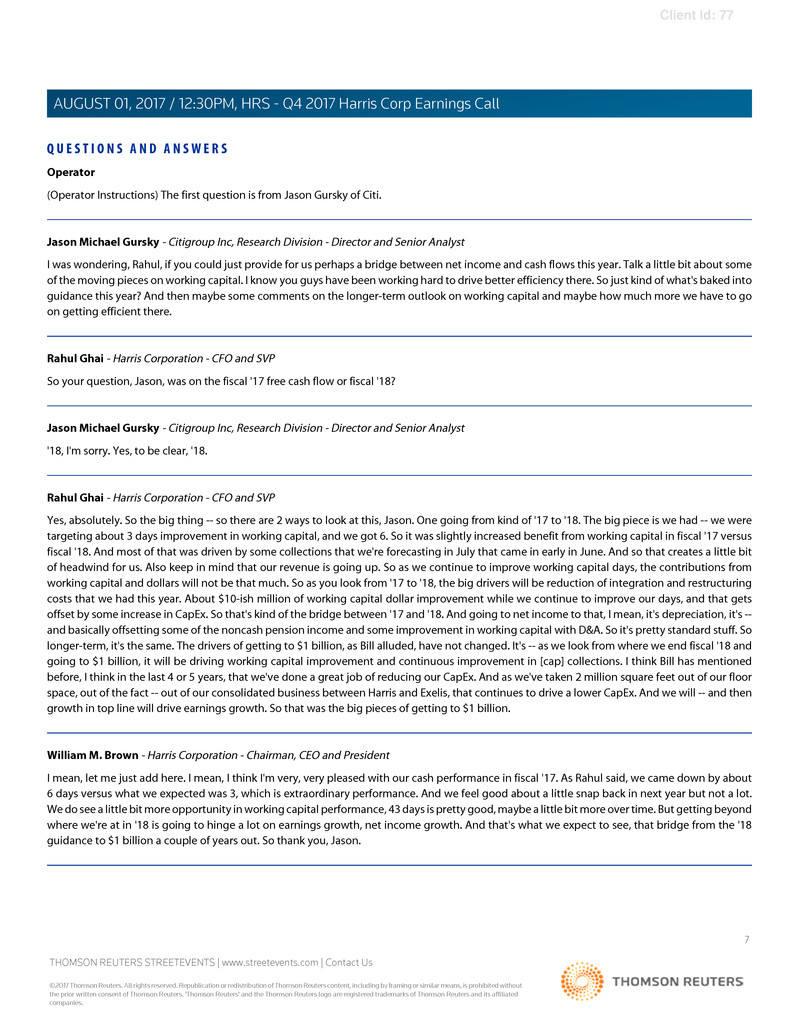
Client Id: 77
Q U E S T I O N S A N D A N S W E R S
Operator
(Operator Instructions) The first question is from Jason Gursky of Citi.
Jason Michael Gursky - Citigroup Inc, Research Division - Director and Senior Analyst
I was wondering, Rahul, if you could just provide for us perhaps a bridge between net income and cash flows this year. Talk a little bit about some
of the moving pieces on working capital. I know you guys have been working hard to drive better efficiency there. So just kind of what's baked into
guidance this year? And then maybe some comments on the longer-term outlook on working capital and maybe how much more we have to go
on getting efficient there.
Rahul Ghai - Harris Corporation - CFO and SVP
So your question, Jason, was on the fiscal '17 free cash flow or fiscal '18?
Jason Michael Gursky - Citigroup Inc, Research Division - Director and Senior Analyst
'18, I'm sorry. Yes, to be clear, '18.
Rahul Ghai - Harris Corporation - CFO and SVP
Yes, absolutely. So the big thing -- so there are 2 ways to look at this, Jason. One going from kind of '17 to '18. The big piece is we had -- we were
targeting about 3 days improvement in working capital, and we got 6. So it was slightly increased benefit from working capital in fiscal '17 versus
fiscal '18. And most of that was driven by some collections that we're forecasting in July that came in early in June. And so that creates a little bit
of headwind for us. Also keep in mind that our revenue is going up. So as we continue to improve working capital days, the contributions from
working capital and dollars will not be that much. So as you look from '17 to '18, the big drivers will be reduction of integration and restructuring
costs that we had this year. About $10-ish million of working capital dollar improvement while we continue to improve our days, and that gets
offset by some increase in CapEx. So that's kind of the bridge between '17 and '18. And going to net income to that, I mean, it's depreciation, it's --
and basically offsetting some of the noncash pension income and some improvement in working capital with D&A. So it's pretty standard stuff. So
longer-term, it's the same. The drivers of getting to $1 billion, as Bill alluded, have not changed. It's -- as we look from where we end fiscal '18 and
going to $1 billion, it will be driving working capital improvement and continuous improvement in [cap] collections. I think Bill has mentioned
before, I think in the last 4 or 5 years, that we've done a great job of reducing our CapEx. And as we've taken 2 million square feet out of our floor
space, out of the fact -- out of our consolidated business between Harris and Exelis, that continues to drive a lower CapEx. And we will -- and then
growth in top line will drive earnings growth. So that was the big pieces of getting to $1 billion.
William M. Brown - Harris Corporation - Chairman, CEO and President
I mean, let me just add here. I mean, I think I'm very, very pleased with our cash performance in fiscal '17. As Rahul said, we came down by about
6 days versus what we expected was 3, which is extraordinary performance. And we feel good about a little snap back in next year but not a lot.
We do see a little bit more opportunity in working capital performance, 43 days is pretty good, maybe a little bit more over time. But getting beyond
where we're at in '18 is going to hinge a lot on earnings growth, net income growth. And that's what we expect to see, that bridge from the '18
guidance to $1 billion a couple of years out. So thank you, Jason.
7
THOMSON REUTERS STREETEVENTS | www.streetevents.com | Contact Us
©2017 Thomson Reuters. All rights reserved. Republication or redistribution of Thomson Reuters content, including by framing or similar means, is prohibited without
the prior written consent of Thomson Reuters. 'Thomson Reuters' and the Thomson Reuters logo are registered trademarks of Thomson Reuters and its affiliated
companies.
AUGUST 01, 2017 / 12:30PM, HRS - Q4 2017 Harris Corp Earnings Call
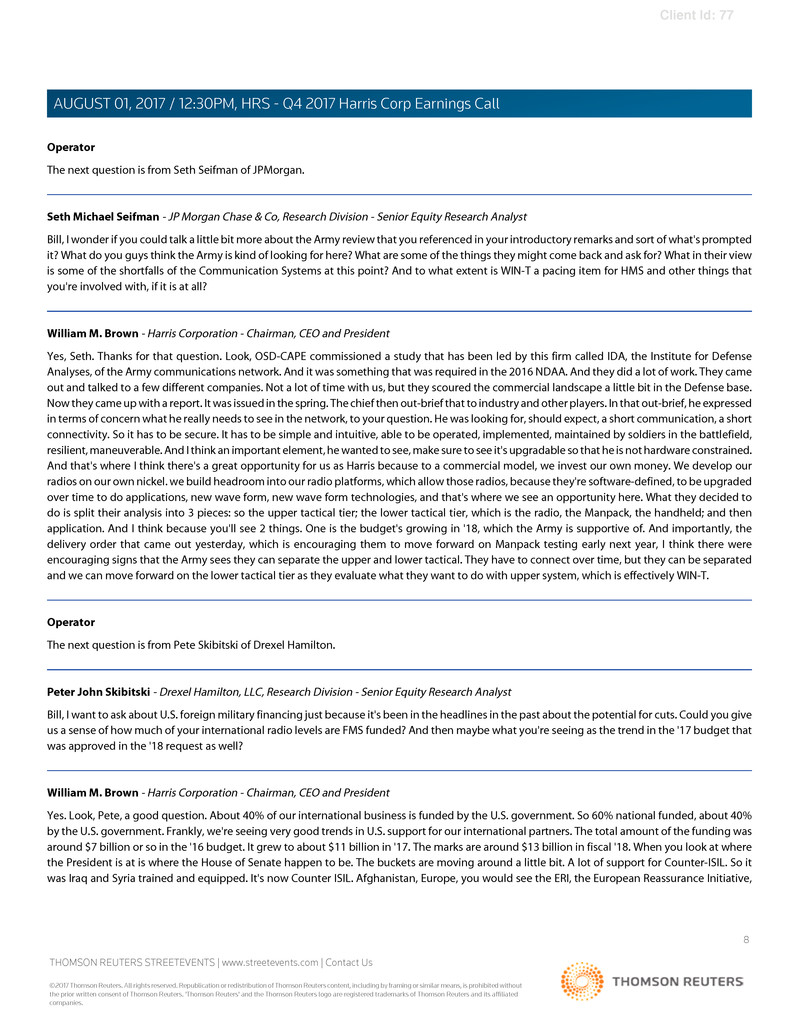
Client Id: 77
Operator
The next question is from Seth Seifman of JPMorgan.
Seth Michael Seifman - JP Morgan Chase & Co, Research Division - Senior Equity Research Analyst
Bill, I wonder if you could talk a little bit more about the Army review that you referenced in your introductory remarks and sort of what's prompted
it? What do you guys think the Army is kind of looking for here? What are some of the things they might come back and ask for? What in their view
is some of the shortfalls of the Communication Systems at this point? And to what extent is WIN-T a pacing item for HMS and other things that
you're involved with, if it is at all?
William M. Brown - Harris Corporation - Chairman, CEO and President
Yes, Seth. Thanks for that question. Look, OSD-CAPE commissioned a study that has been led by this firm called IDA, the Institute for Defense
Analyses, of the Army communications network. And it was something that was required in the 2016 NDAA. And they did a lot of work. They came
out and talked to a few different companies. Not a lot of time with us, but they scoured the commercial landscape a little bit in the Defense base.
Now they came up with a report. It was issued in the spring. The chief then out-brief that to industry and other players. In that out-brief, he expressed
in terms of concern what he really needs to see in the network, to your question. He was looking for, should expect, a short communication, a short
connectivity. So it has to be secure. It has to be simple and intuitive, able to be operated, implemented, maintained by soldiers in the battlefield,
resilient, maneuverable. And I think an important element, he wanted to see, make sure to see it's upgradable so that he is not hardware constrained.
And that's where I think there's a great opportunity for us as Harris because to a commercial model, we invest our own money. We develop our
radios on our own nickel. we build headroom into our radio platforms, which allow those radios, because they're software-defined, to be upgraded
over time to do applications, new wave form, new wave form technologies, and that's where we see an opportunity here. What they decided to
do is split their analysis into 3 pieces: so the upper tactical tier; the lower tactical tier, which is the radio, the Manpack, the handheld; and then
application. And I think because you'll see 2 things. One is the budget's growing in '18, which the Army is supportive of. And importantly, the
delivery order that came out yesterday, which is encouraging them to move forward on Manpack testing early next year, I think there were
encouraging signs that the Army sees they can separate the upper and lower tactical. They have to connect over time, but they can be separated
and we can move forward on the lower tactical tier as they evaluate what they want to do with upper system, which is effectively WIN-T.
Operator
The next question is from Pete Skibitski of Drexel Hamilton.
Peter John Skibitski - Drexel Hamilton, LLC, Research Division - Senior Equity Research Analyst
Bill, I want to ask about U.S. foreign military financing just because it's been in the headlines in the past about the potential for cuts. Could you give
us a sense of how much of your international radio levels are FMS funded? And then maybe what you're seeing as the trend in the '17 budget that
was approved in the '18 request as well?
William M. Brown - Harris Corporation - Chairman, CEO and President
Yes. Look, Pete, a good question. About 40% of our international business is funded by the U.S. government. So 60% national funded, about 40%
by the U.S. government. Frankly, we're seeing very good trends in U.S. support for our international partners. The total amount of the funding was
around $7 billion or so in the '16 budget. It grew to about $11 billion in '17. The marks are around $13 billion in fiscal '18. When you look at where
the President is at is where the House of Senate happen to be. The buckets are moving around a little bit. A lot of support for Counter-ISIL. So it
was Iraq and Syria trained and equipped. It's now Counter ISIL. Afghanistan, Europe, you would see the ERI, the European Reassurance Initiative,
8
THOMSON REUTERS STREETEVENTS | www.streetevents.com | Contact Us
©2017 Thomson Reuters. All rights reserved. Republication or redistribution of Thomson Reuters content, including by framing or similar means, is prohibited without
the prior written consent of Thomson Reuters. 'Thomson Reuters' and the Thomson Reuters logo are registered trademarks of Thomson Reuters and its affiliated
companies.
AUGUST 01, 2017 / 12:30PM, HRS - Q4 2017 Harris Corp Earnings Call
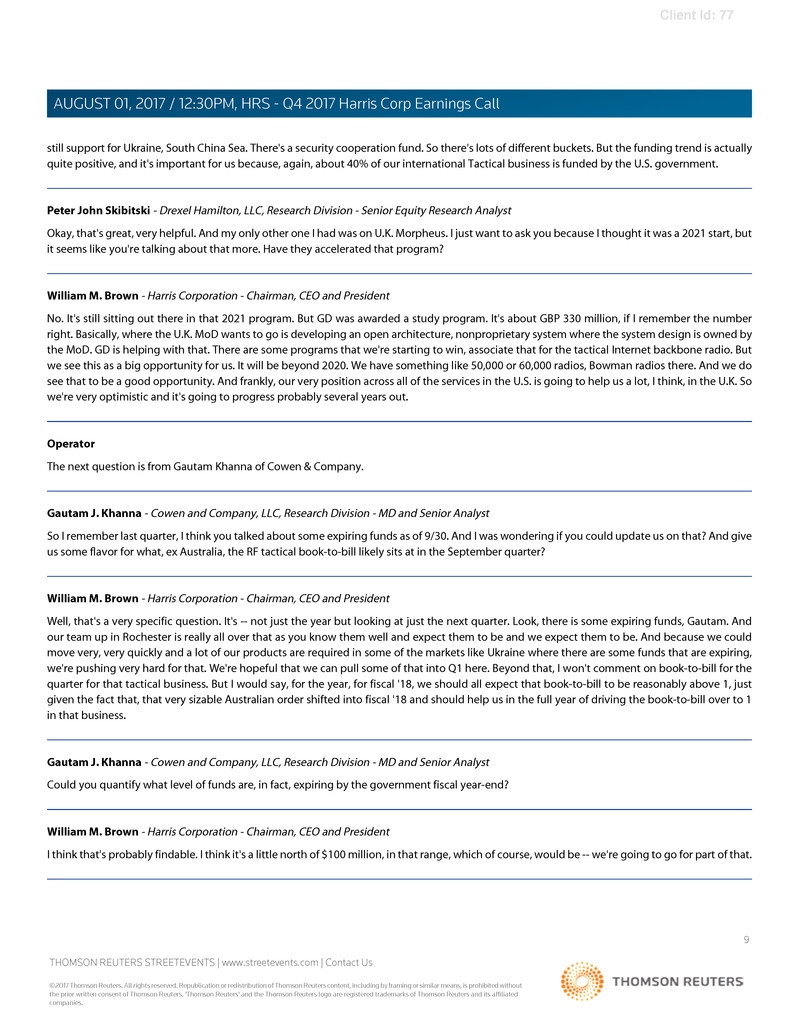
Client Id: 77
still support for Ukraine, South China Sea. There's a security cooperation fund. So there's lots of different buckets. But the funding trend is actually
quite positive, and it's important for us because, again, about 40% of our international Tactical business is funded by the U.S. government.
Peter John Skibitski - Drexel Hamilton, LLC, Research Division - Senior Equity Research Analyst
Okay, that's great, very helpful. And my only other one I had was on U.K. Morpheus. I just want to ask you because I thought it was a 2021 start, but
it seems like you're talking about that more. Have they accelerated that program?
William M. Brown - Harris Corporation - Chairman, CEO and President
No. It's still sitting out there in that 2021 program. But GD was awarded a study program. It's about GBP 330 million, if I remember the number
right. Basically, where the U.K. MoD wants to go is developing an open architecture, nonproprietary system where the system design is owned by
the MoD. GD is helping with that. There are some programs that we're starting to win, associate that for the tactical Internet backbone radio. But
we see this as a big opportunity for us. It will be beyond 2020. We have something like 50,000 or 60,000 radios, Bowman radios there. And we do
see that to be a good opportunity. And frankly, our very position across all of the services in the U.S. is going to help us a lot, I think, in the U.K. So
we're very optimistic and it's going to progress probably several years out.
Operator
The next question is from Gautam Khanna of Cowen & Company.
Gautam J. Khanna - Cowen and Company, LLC, Research Division - MD and Senior Analyst
So I remember last quarter, I think you talked about some expiring funds as of 9/30. And I was wondering if you could update us on that? And give
us some flavor for what, ex Australia, the RF tactical book-to-bill likely sits at in the September quarter?
William M. Brown - Harris Corporation - Chairman, CEO and President
Well, that's a very specific question. It's -- not just the year but looking at just the next quarter. Look, there is some expiring funds, Gautam. And
our team up in Rochester is really all over that as you know them well and expect them to be and we expect them to be. And because we could
move very, very quickly and a lot of our products are required in some of the markets like Ukraine where there are some funds that are expiring,
we're pushing very hard for that. We're hopeful that we can pull some of that into Q1 here. Beyond that, I won't comment on book-to-bill for the
quarter for that tactical business. But I would say, for the year, for fiscal '18, we should all expect that book-to-bill to be reasonably above 1, just
given the fact that, that very sizable Australian order shifted into fiscal '18 and should help us in the full year of driving the book-to-bill over to 1
in that business.
Gautam J. Khanna - Cowen and Company, LLC, Research Division - MD and Senior Analyst
Could you quantify what level of funds are, in fact, expiring by the government fiscal year-end?
William M. Brown - Harris Corporation - Chairman, CEO and President
I think that's probably findable. I think it's a little north of $100 million, in that range, which of course, would be -- we're going to go for part of that.
9
THOMSON REUTERS STREETEVENTS | www.streetevents.com | Contact Us
©2017 Thomson Reuters. All rights reserved. Republication or redistribution of Thomson Reuters content, including by framing or similar means, is prohibited without
the prior written consent of Thomson Reuters. 'Thomson Reuters' and the Thomson Reuters logo are registered trademarks of Thomson Reuters and its affiliated
companies.
AUGUST 01, 2017 / 12:30PM, HRS - Q4 2017 Harris Corp Earnings Call

Client Id: 77
Gautam J. Khanna - Cowen and Company, LLC, Research Division - MD and Senior Analyst
Sure, okay. And then on Australia, so assuming that you book it this quarter, how quickly do you start to ship on it? And could you remind us again
of the profile of it? I remember the radios were sort of at the back end and some of the systems integration at the front end. If you could just give
us some flavor on how much revenue from Australia is booked into the current fiscal year and how much you expect to get in subsequent years?
William M. Brown - Harris Corporation - Chairman, CEO and President
Yes, sure. Look, the -- we are confident it's going to come here in the first quarter. I think as Rahul pointed out, the Investment Committee approval
was very substantial. Getting a letter of intent following that was very important. Getting an advanced order, if you will, for some risk reduction
activities in Q4, again, was very encouraging for us. It only has to go through the National Security Council, which is scheduled the end of August.
So we're feeling pretty good that it's going to come in that range that Rahul mentioned, about $260 million. As we said last time, it's about a 3-year
program. It's going to roll into '18. It will ramp a little bit more in '19 and '20. This year, we think it's going to be about $60 million more or less of
revenue and in the balance -- in the out years. And yes, the radio's a little bit further in the back end. But overall margins, I think, will be reasonably
good for that particular program and won't dilute the overall segment margins given where our guidance happens to be in fiscal '18.
Rahul Ghai - Harris Corporation - CFO and SVP
And the only other thing, Gautam, I would say is that given the order that we got in fourth quarter allowed us to keep the program on track with
some of the development risk reduction and other work. So that way, the slight delay in order did not impact the revenue profile. So that was
important.
Gautam J. Khanna - Cowen and Company, LLC, Research Division - MD and Senior Analyst
Okay, that's helpful. And then given the pipeline metrics in prior quarters, I was wondering if you could update us DoD versus international and
then also what your current thinking is for timing of the Manpack orders. Is it still the spring of next year, and therefore, not much in the way of
revenue is assumed, from the HMS Manpack program in the current fiscal year?
William M. Brown - Harris Corporation - Chairman, CEO and President
Yes, Gautam. Look, on the DoD side, the pipeline is about $1,500,000,000. So it's up a little bit from last time and up pretty substantially from the
beginning of the year as we start to see more of the monetization opportunities come in to the pipeline. So it's about $1,500,000,000. The international
is around $2.5 billion. The shape of it is not changing a whole lot. A lot of it is Middle East, but that's not changing a lot. And it's pretty much in line
with where we were last quarter, around $2.4 billion. So again, very healthy and continued healthy pipeline associated with the Tactical business.
Now on the Manpack. Like I said, I'm encouraged about this delivery order that we got yesterday. It ships in the early part of next year. I think the
date is sometime early in April. They'll do a field-based risk reduction effort, and that'll be in the April, May, June time frame. We'll get some guidance
in the coming weeks on the RFP time frame. I think it's probably still in that March, April, May time frame. If there's revenue in the Manpack, it'll be
very late in fiscal '18. It could shift into fiscal '19. But right now, we still see at least some coming at the back end of the year, certainly some revenue
associated with this delivery order.
Operator
The next question is from Noah Poponak of Goldman Sachs.
10
THOMSON REUTERS STREETEVENTS | www.streetevents.com | Contact Us
©2017 Thomson Reuters. All rights reserved. Republication or redistribution of Thomson Reuters content, including by framing or similar means, is prohibited without
the prior written consent of Thomson Reuters. 'Thomson Reuters' and the Thomson Reuters logo are registered trademarks of Thomson Reuters and its affiliated
companies.
AUGUST 01, 2017 / 12:30PM, HRS - Q4 2017 Harris Corp Earnings Call
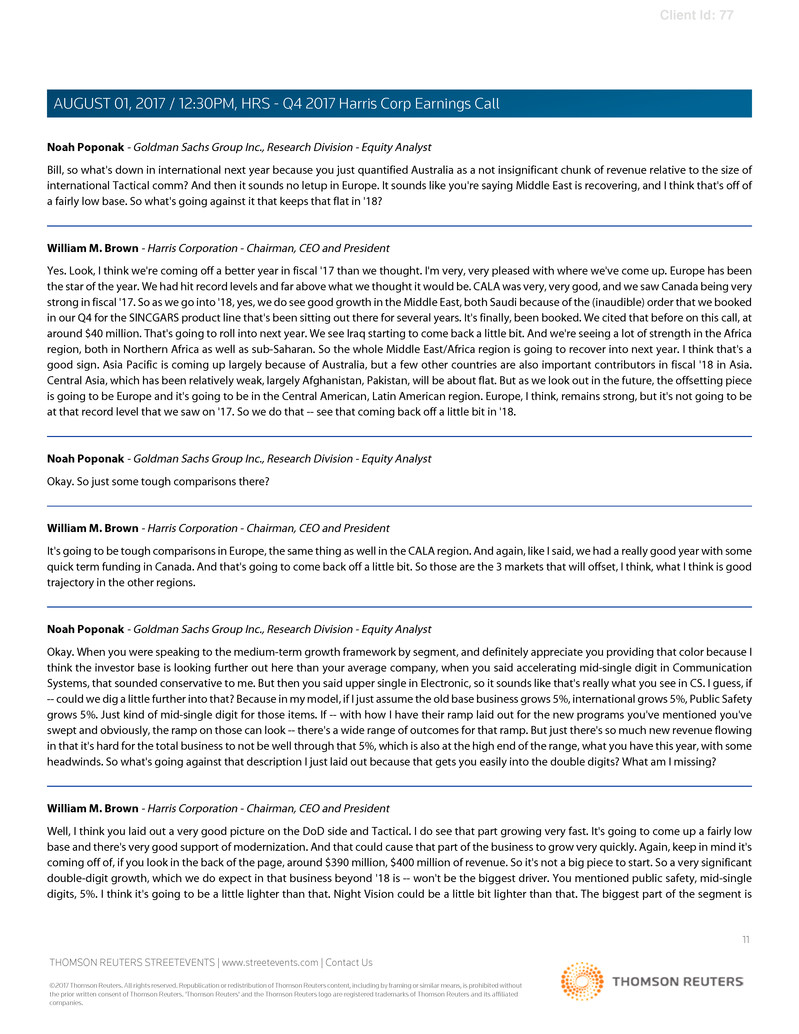
Client Id: 77
Noah Poponak - Goldman Sachs Group Inc., Research Division - Equity Analyst
Bill, so what's down in international next year because you just quantified Australia as a not insignificant chunk of revenue relative to the size of
international Tactical comm? And then it sounds no letup in Europe. It sounds like you're saying Middle East is recovering, and I think that's off of
a fairly low base. So what's going against it that keeps that flat in '18?
William M. Brown - Harris Corporation - Chairman, CEO and President
Yes. Look, I think we're coming off a better year in fiscal '17 than we thought. I'm very, very pleased with where we've come up. Europe has been
the star of the year. We had hit record levels and far above what we thought it would be. CALA was very, very good, and we saw Canada being very
strong in fiscal '17. So as we go into '18, yes, we do see good growth in the Middle East, both Saudi because of the (inaudible) order that we booked
in our Q4 for the SINCGARS product line that's been sitting out there for several years. It's finally, been booked. We cited that before on this call, at
around $40 million. That's going to roll into next year. We see Iraq starting to come back a little bit. And we're seeing a lot of strength in the Africa
region, both in Northern Africa as well as sub-Saharan. So the whole Middle East/Africa region is going to recover into next year. I think that's a
good sign. Asia Pacific is coming up largely because of Australia, but a few other countries are also important contributors in fiscal '18 in Asia.
Central Asia, which has been relatively weak, largely Afghanistan, Pakistan, will be about flat. But as we look out in the future, the offsetting piece
is going to be Europe and it's going to be in the Central American, Latin American region. Europe, I think, remains strong, but it's not going to be
at that record level that we saw on '17. So we do that -- see that coming back off a little bit in '18.
Noah Poponak - Goldman Sachs Group Inc., Research Division - Equity Analyst
Okay. So just some tough comparisons there?
William M. Brown - Harris Corporation - Chairman, CEO and President
It's going to be tough comparisons in Europe, the same thing as well in the CALA region. And again, like I said, we had a really good year with some
quick term funding in Canada. And that's going to come back off a little bit. So those are the 3 markets that will offset, I think, what I think is good
trajectory in the other regions.
Noah Poponak - Goldman Sachs Group Inc., Research Division - Equity Analyst
Okay. When you were speaking to the medium-term growth framework by segment, and definitely appreciate you providing that color because I
think the investor base is looking further out here than your average company, when you said accelerating mid-single digit in Communication
Systems, that sounded conservative to me. But then you said upper single in Electronic, so it sounds like that's really what you see in CS. I guess, if
-- could we dig a little further into that? Because in my model, if I just assume the old base business grows 5%, international grows 5%, Public Safety
grows 5%. Just kind of mid-single digit for those items. If -- with how I have their ramp laid out for the new programs you've mentioned you've
swept and obviously, the ramp on those can look -- there's a wide range of outcomes for that ramp. But just there's so much new revenue flowing
in that it's hard for the total business to not be well through that 5%, which is also at the high end of the range, what you have this year, with some
headwinds. So what's going against that description I just laid out because that gets you easily into the double digits? What am I missing?
William M. Brown - Harris Corporation - Chairman, CEO and President
Well, I think you laid out a very good picture on the DoD side and Tactical. I do see that part growing very fast. It's going to come up a fairly low
base and there's very good support of modernization. And that could cause that part of the business to grow very quickly. Again, keep in mind it's
coming off of, if you look in the back of the page, around $390 million, $400 million of revenue. So it's not a big piece to start. So a very significant
double-digit growth, which we do expect in that business beyond '18 is -- won't be the biggest driver. You mentioned public safety, mid-single
digits, 5%. I think it's going to be a little lighter than that. Night Vision could be a little bit lighter than that. The biggest part of the segment is
11
THOMSON REUTERS STREETEVENTS | www.streetevents.com | Contact Us
©2017 Thomson Reuters. All rights reserved. Republication or redistribution of Thomson Reuters content, including by framing or similar means, is prohibited without
the prior written consent of Thomson Reuters. 'Thomson Reuters' and the Thomson Reuters logo are registered trademarks of Thomson Reuters and its affiliated
companies.
AUGUST 01, 2017 / 12:30PM, HRS - Q4 2017 Harris Corp Earnings Call
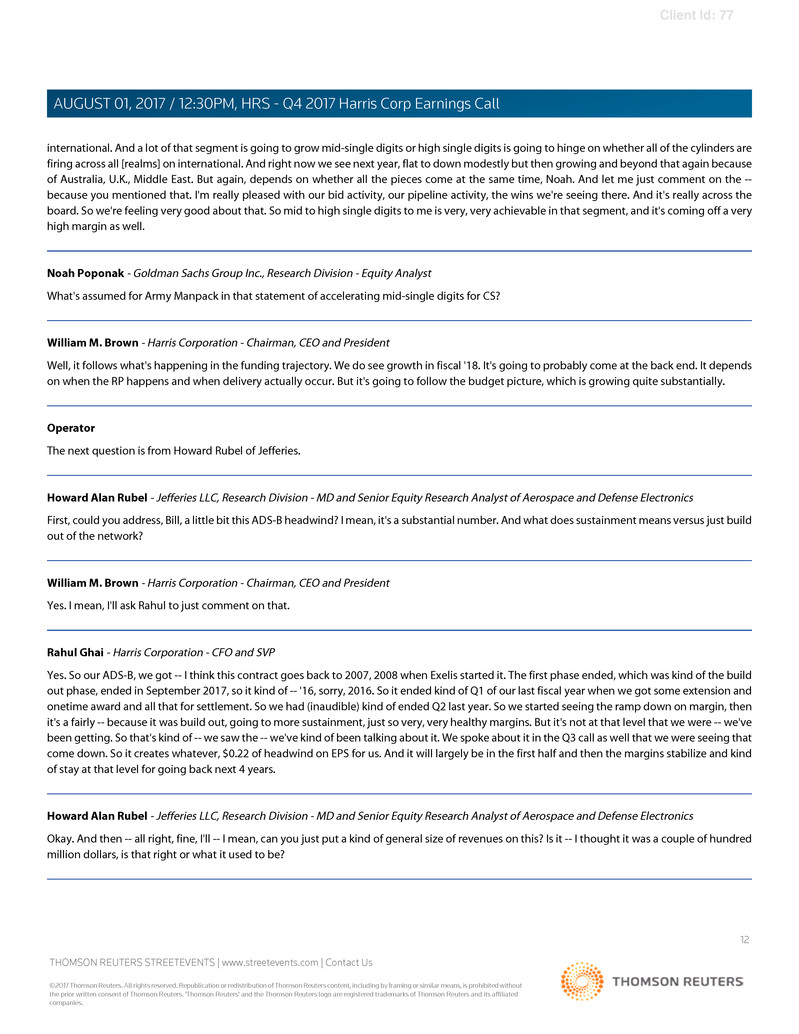
Client Id: 77
international. And a lot of that segment is going to grow mid-single digits or high single digits is going to hinge on whether all of the cylinders are
firing across all [realms] on international. And right now we see next year, flat to down modestly but then growing and beyond that again because
of Australia, U.K., Middle East. But again, depends on whether all the pieces come at the same time, Noah. And let me just comment on the --
because you mentioned that. I'm really pleased with our bid activity, our pipeline activity, the wins we're seeing there. And it's really across the
board. So we're feeling very good about that. So mid to high single digits to me is very, very achievable in that segment, and it's coming off a very
high margin as well.
Noah Poponak - Goldman Sachs Group Inc., Research Division - Equity Analyst
What's assumed for Army Manpack in that statement of accelerating mid-single digits for CS?
William M. Brown - Harris Corporation - Chairman, CEO and President
Well, it follows what's happening in the funding trajectory. We do see growth in fiscal '18. It's going to probably come at the back end. It depends
on when the RP happens and when delivery actually occur. But it's going to follow the budget picture, which is growing quite substantially.
Operator
The next question is from Howard Rubel of Jefferies.
Howard Alan Rubel - Jefferies LLC, Research Division - MD and Senior Equity Research Analyst of Aerospace and Defense Electronics
First, could you address, Bill, a little bit this ADS-B headwind? I mean, it's a substantial number. And what does sustainment means versus just build
out of the network?
William M. Brown - Harris Corporation - Chairman, CEO and President
Yes. I mean, I'll ask Rahul to just comment on that.
Rahul Ghai - Harris Corporation - CFO and SVP
Yes. So our ADS-B, we got -- I think this contract goes back to 2007, 2008 when Exelis started it. The first phase ended, which was kind of the build
out phase, ended in September 2017, so it kind of -- '16, sorry, 2016. So it ended kind of Q1 of our last fiscal year when we got some extension and
onetime award and all that for settlement. So we had (inaudible) kind of ended Q2 last year. So we started seeing the ramp down on margin, then
it's a fairly -- because it was build out, going to more sustainment, just so very, very healthy margins. But it's not at that level that we were -- we've
been getting. So that's kind of -- we saw the -- we've kind of been talking about it. We spoke about it in the Q3 call as well that we were seeing that
come down. So it creates whatever, $0.22 of headwind on EPS for us. And it will largely be in the first half and then the margins stabilize and kind
of stay at that level for going back next 4 years.
Howard Alan Rubel - Jefferies LLC, Research Division - MD and Senior Equity Research Analyst of Aerospace and Defense Electronics
Okay. And then -- all right, fine, I'll -- I mean, can you just put a kind of general size of revenues on this? Is it -- I thought it was a couple of hundred
million dollars, is that right or what it used to be?
12
THOMSON REUTERS STREETEVENTS | www.streetevents.com | Contact Us
©2017 Thomson Reuters. All rights reserved. Republication or redistribution of Thomson Reuters content, including by framing or similar means, is prohibited without
the prior written consent of Thomson Reuters. 'Thomson Reuters' and the Thomson Reuters logo are registered trademarks of Thomson Reuters and its affiliated
companies.
AUGUST 01, 2017 / 12:30PM, HRS - Q4 2017 Harris Corp Earnings Call
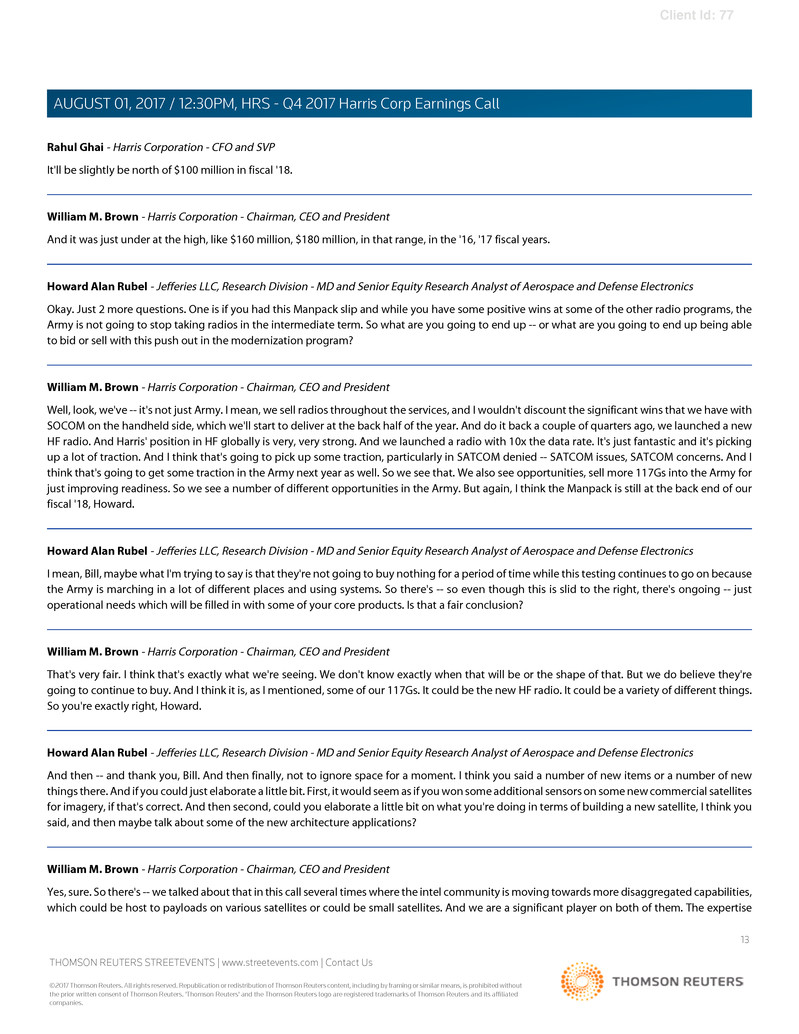
Client Id: 77
Rahul Ghai - Harris Corporation - CFO and SVP
It'll be slightly be north of $100 million in fiscal '18.
William M. Brown - Harris Corporation - Chairman, CEO and President
And it was just under at the high, like $160 million, $180 million, in that range, in the '16, '17 fiscal years.
Howard Alan Rubel - Jefferies LLC, Research Division - MD and Senior Equity Research Analyst of Aerospace and Defense Electronics
Okay. Just 2 more questions. One is if you had this Manpack slip and while you have some positive wins at some of the other radio programs, the
Army is not going to stop taking radios in the intermediate term. So what are you going to end up -- or what are you going to end up being able
to bid or sell with this push out in the modernization program?
William M. Brown - Harris Corporation - Chairman, CEO and President
Well, look, we've -- it's not just Army. I mean, we sell radios throughout the services, and I wouldn't discount the significant wins that we have with
SOCOM on the handheld side, which we'll start to deliver at the back half of the year. And do it back a couple of quarters ago, we launched a new
HF radio. And Harris' position in HF globally is very, very strong. And we launched a radio with 10x the data rate. It's just fantastic and it's picking
up a lot of traction. And I think that's going to pick up some traction, particularly in SATCOM denied -- SATCOM issues, SATCOM concerns. And I
think that's going to get some traction in the Army next year as well. So we see that. We also see opportunities, sell more 117Gs into the Army for
just improving readiness. So we see a number of different opportunities in the Army. But again, I think the Manpack is still at the back end of our
fiscal '18, Howard.
Howard Alan Rubel - Jefferies LLC, Research Division - MD and Senior Equity Research Analyst of Aerospace and Defense Electronics
I mean, Bill, maybe what I'm trying to say is that they're not going to buy nothing for a period of time while this testing continues to go on because
the Army is marching in a lot of different places and using systems. So there's -- so even though this is slid to the right, there's ongoing -- just
operational needs which will be filled in with some of your core products. Is that a fair conclusion?
William M. Brown - Harris Corporation - Chairman, CEO and President
That's very fair. I think that's exactly what we're seeing. We don't know exactly when that will be or the shape of that. But we do believe they're
going to continue to buy. And I think it is, as I mentioned, some of our 117Gs. It could be the new HF radio. It could be a variety of different things.
So you're exactly right, Howard.
Howard Alan Rubel - Jefferies LLC, Research Division - MD and Senior Equity Research Analyst of Aerospace and Defense Electronics
And then -- and thank you, Bill. And then finally, not to ignore space for a moment. I think you said a number of new items or a number of new
things there. And if you could just elaborate a little bit. First, it would seem as if you won some additional sensors on some new commercial satellites
for imagery, if that's correct. And then second, could you elaborate a little bit on what you're doing in terms of building a new satellite, I think you
said, and then maybe talk about some of the new architecture applications?
William M. Brown - Harris Corporation - Chairman, CEO and President
Yes, sure. So there's -- we talked about that in this call several times where the intel community is moving towards more disaggregated capabilities,
which could be host to payloads on various satellites or could be small satellites. And we are a significant player on both of them. The expertise
13
THOMSON REUTERS STREETEVENTS | www.streetevents.com | Contact Us
©2017 Thomson Reuters. All rights reserved. Republication or redistribution of Thomson Reuters content, including by framing or similar means, is prohibited without
the prior written consent of Thomson Reuters. 'Thomson Reuters' and the Thomson Reuters logo are registered trademarks of Thomson Reuters and its affiliated
companies.
AUGUST 01, 2017 / 12:30PM, HRS - Q4 2017 Harris Corp Earnings Call
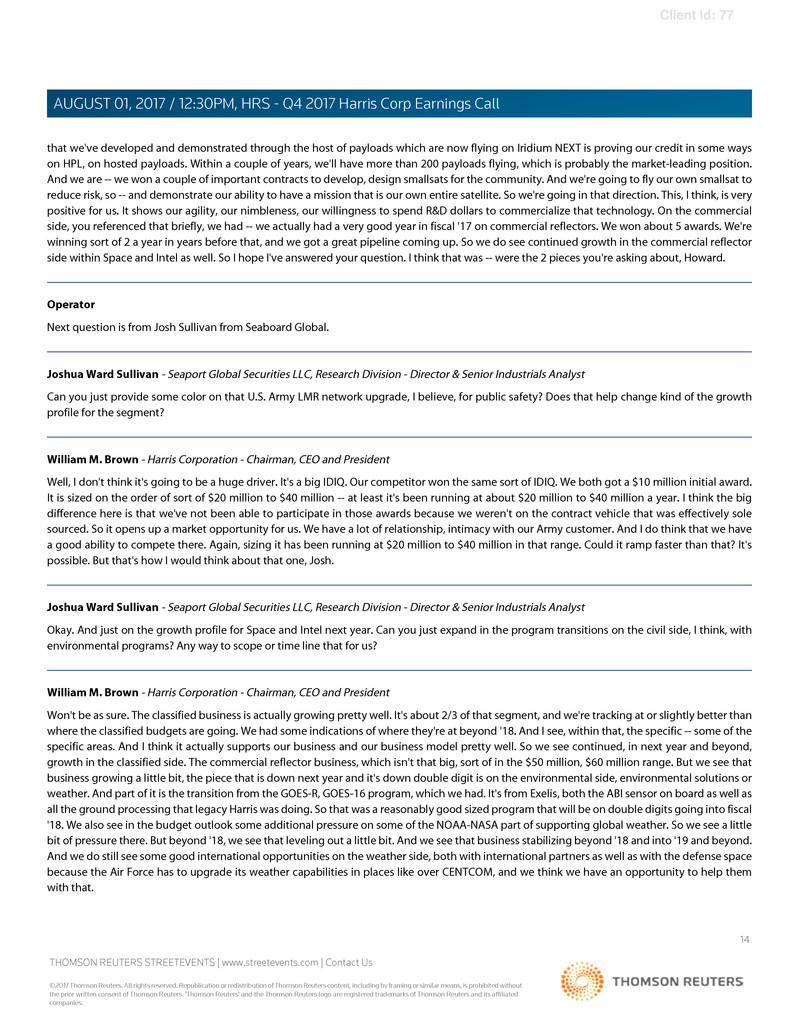
Client Id: 77
that we've developed and demonstrated through the host of payloads which are now flying on Iridium NEXT is proving our credit in some ways
on HPL, on hosted payloads. Within a couple of years, we'll have more than 200 payloads flying, which is probably the market-leading position.
And we are -- we won a couple of important contracts to develop, design smallsats for the community. And we're going to fly our own smallsat to
reduce risk, so -- and demonstrate our ability to have a mission that is our own entire satellite. So we're going in that direction. This, I think, is very
positive for us. It shows our agility, our nimbleness, our willingness to spend R&D dollars to commercialize that technology. On the commercial
side, you referenced that briefly, we had -- we actually had a very good year in fiscal '17 on commercial reflectors. We won about 5 awards. We're
winning sort of 2 a year in years before that, and we got a great pipeline coming up. So we do see continued growth in the commercial reflector
side within Space and Intel as well. So I hope I've answered your question. I think that was -- were the 2 pieces you're asking about, Howard.
Operator
Next question is from Josh Sullivan from Seaboard Global.
Joshua Ward Sullivan - Seaport Global Securities LLC, Research Division - Director & Senior Industrials Analyst
Can you just provide some color on that U.S. Army LMR network upgrade, I believe, for public safety? Does that help change kind of the growth
profile for the segment?
William M. Brown - Harris Corporation - Chairman, CEO and President
Well, I don't think it's going to be a huge driver. It's a big IDIQ. Our competitor won the same sort of IDIQ. We both got a $10 million initial award.
It is sized on the order of sort of $20 million to $40 million -- at least it's been running at about $20 million to $40 million a year. I think the big
difference here is that we've not been able to participate in those awards because we weren't on the contract vehicle that was effectively sole
sourced. So it opens up a market opportunity for us. We have a lot of relationship, intimacy with our Army customer. And I do think that we have
a good ability to compete there. Again, sizing it has been running at $20 million to $40 million in that range. Could it ramp faster than that? It's
possible. But that's how I would think about that one, Josh.
Joshua Ward Sullivan - Seaport Global Securities LLC, Research Division - Director & Senior Industrials Analyst
Okay. And just on the growth profile for Space and Intel next year. Can you just expand in the program transitions on the civil side, I think, with
environmental programs? Any way to scope or time line that for us?
William M. Brown - Harris Corporation - Chairman, CEO and President
Won't be as sure. The classified business is actually growing pretty well. It's about 2/3 of that segment, and we're tracking at or slightly better than
where the classified budgets are going. We had some indications of where they're at beyond '18. And I see, within that, the specific -- some of the
specific areas. And I think it actually supports our business and our business model pretty well. So we see continued, in next year and beyond,
growth in the classified side. The commercial reflector business, which isn't that big, sort of in the $50 million, $60 million range. But we see that
business growing a little bit, the piece that is down next year and it's down double digit is on the environmental side, environmental solutions or
weather. And part of it is the transition from the GOES-R, GOES-16 program, which we had. It's from Exelis, both the ABI sensor on board as well as
all the ground processing that legacy Harris was doing. So that was a reasonably good sized program that will be on double digits going into fiscal
'18. We also see in the budget outlook some additional pressure on some of the NOAA-NASA part of supporting global weather. So we see a little
bit of pressure there. But beyond '18, we see that leveling out a little bit. And we see that business stabilizing beyond '18 and into '19 and beyond.
And we do still see some good international opportunities on the weather side, both with international partners as well as with the defense space
because the Air Force has to upgrade its weather capabilities in places like over CENTCOM, and we think we have an opportunity to help them
with that.
14
THOMSON REUTERS STREETEVENTS | www.streetevents.com | Contact Us
©2017 Thomson Reuters. All rights reserved. Republication or redistribution of Thomson Reuters content, including by framing or similar means, is prohibited without
the prior written consent of Thomson Reuters. 'Thomson Reuters' and the Thomson Reuters logo are registered trademarks of Thomson Reuters and its affiliated
companies.
AUGUST 01, 2017 / 12:30PM, HRS - Q4 2017 Harris Corp Earnings Call
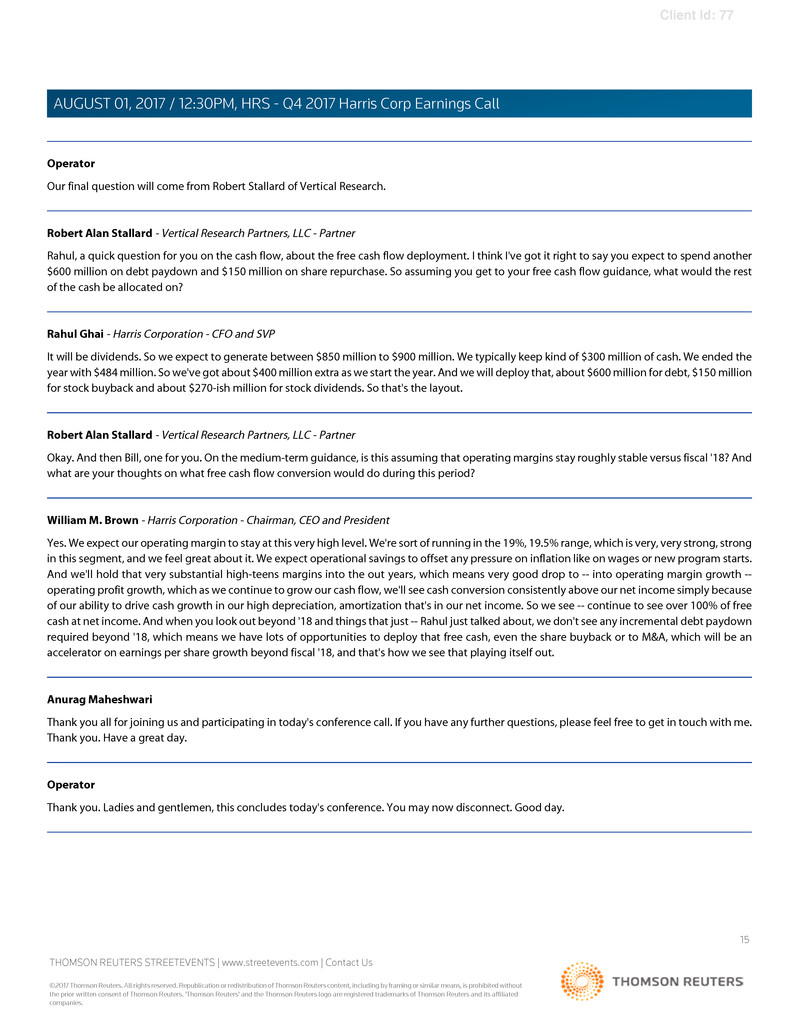
Client Id: 77
Operator
Our final question will come from Robert Stallard of Vertical Research.
Robert Alan Stallard - Vertical Research Partners, LLC - Partner
Rahul, a quick question for you on the cash flow, about the free cash flow deployment. I think I've got it right to say you expect to spend another
$600 million on debt paydown and $150 million on share repurchase. So assuming you get to your free cash flow guidance, what would the rest
of the cash be allocated on?
Rahul Ghai - Harris Corporation - CFO and SVP
It will be dividends. So we expect to generate between $850 million to $900 million. We typically keep kind of $300 million of cash. We ended the
year with $484 million. So we've got about $400 million extra as we start the year. And we will deploy that, about $600 million for debt, $150 million
for stock buyback and about $270-ish million for stock dividends. So that's the layout.
Robert Alan Stallard - Vertical Research Partners, LLC - Partner
Okay. And then Bill, one for you. On the medium-term guidance, is this assuming that operating margins stay roughly stable versus fiscal '18? And
what are your thoughts on what free cash flow conversion would do during this period?
William M. Brown - Harris Corporation - Chairman, CEO and President
Yes. We expect our operating margin to stay at this very high level. We're sort of running in the 19%, 19.5% range, which is very, very strong, strong
in this segment, and we feel great about it. We expect operational savings to offset any pressure on inflation like on wages or new program starts.
And we'll hold that very substantial high-teens margins into the out years, which means very good drop to -- into operating margin growth --
operating profit growth, which as we continue to grow our cash flow, we'll see cash conversion consistently above our net income simply because
of our ability to drive cash growth in our high depreciation, amortization that's in our net income. So we see -- continue to see over 100% of free
cash at net income. And when you look out beyond '18 and things that just -- Rahul just talked about, we don't see any incremental debt paydown
required beyond '18, which means we have lots of opportunities to deploy that free cash, even the share buyback or to M&A, which will be an
accelerator on earnings per share growth beyond fiscal '18, and that's how we see that playing itself out.
Anurag Maheshwari
Thank you all for joining us and participating in today's conference call. If you have any further questions, please feel free to get in touch with me.
Thank you. Have a great day.
Operator
Thank you. Ladies and gentlemen, this concludes today's conference. You may now disconnect. Good day.
15
THOMSON REUTERS STREETEVENTS | www.streetevents.com | Contact Us
©2017 Thomson Reuters. All rights reserved. Republication or redistribution of Thomson Reuters content, including by framing or similar means, is prohibited without
the prior written consent of Thomson Reuters. 'Thomson Reuters' and the Thomson Reuters logo are registered trademarks of Thomson Reuters and its affiliated
companies.
AUGUST 01, 2017 / 12:30PM, HRS - Q4 2017 Harris Corp Earnings Call
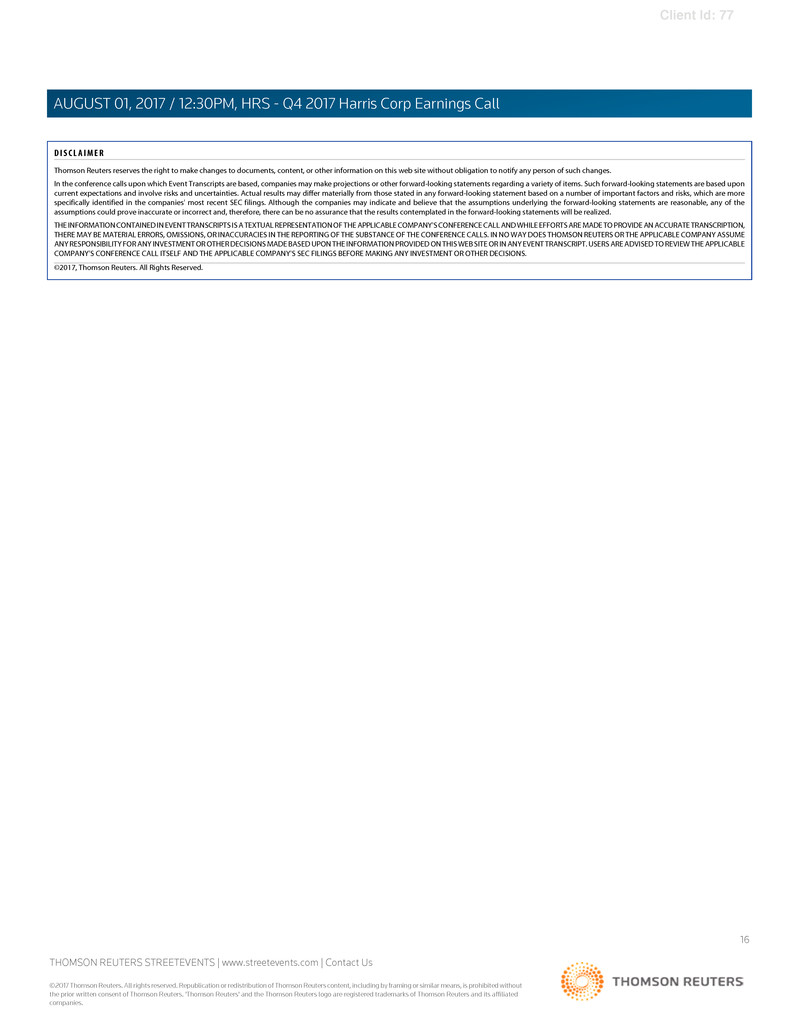
Client Id: 77
D I S C L A I M E R
Thomson Reuters reserves the right to make changes to documents, content, or other information on this web site without obligation to notify any person of such changes.
In the conference calls upon which Event Transcripts are based, companies may make projections or other forward-looking statements regarding a variety of items. Such forward-looking statements are based upon
current expectations and involve risks and uncertainties. Actual results may differ materially from those stated in any forward-looking statement based on a number of important factors and risks, which are more
specifically identified in the companies' most recent SEC filings. Although the companies may indicate and believe that the assumptions underlying the forward-looking statements are reasonable, any of the
assumptions could prove inaccurate or incorrect and, therefore, there can be no assurance that the results contemplated in the forward-looking statements will be realized.
THE INFORMATION CONTAINED IN EVENT TRANSCRIPTS IS A TEXTUAL REPRESENTATION OF THE APPLICABLE COMPANY'S CONFERENCE CALL AND WHILE EFFORTS ARE MADE TO PROVIDE AN ACCURATE TRANSCRIPTION,
THERE MAY BE MATERIAL ERRORS, OMISSIONS, OR INACCURACIES IN THE REPORTING OF THE SUBSTANCE OF THE CONFERENCE CALLS. IN NO WAY DOES THOMSON REUTERS OR THE APPLICABLE COMPANY ASSUME
ANY RESPONSIBILITY FOR ANY INVESTMENT OR OTHER DECISIONS MADE BASED UPON THE INFORMATION PROVIDED ON THIS WEB SITE OR IN ANY EVENT TRANSCRIPT. USERS ARE ADVISED TO REVIEW THE APPLICABLE
COMPANY'S CONFERENCE CALL ITSELF AND THE APPLICABLE COMPANY'S SEC FILINGS BEFORE MAKING ANY INVESTMENT OR OTHER DECISIONS.
©2017, Thomson Reuters. All Rights Reserved. 10736661-2017-08-01T16:02:43.213
16
THOMSON REUTERS STREETEVENTS | www.streetevents.com | Contact Us
©2017 Thomson Reuters. All rights reserved. Republication or redistribution of Thomson Reuters content, including by framing or similar means, is prohibited without
the prior written consent of Thomson Reuters. 'Thomson Reuters' and the Thomson Reuters logo are registered trademarks of Thomson Reuters and its affiliated
companies.
AUGUST 01, 2017 / 12:30PM, HRS - Q4 2017 Harris Corp Earnings Call
